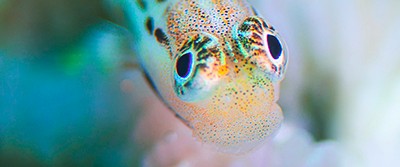Tiny Fish Have Big Impact on Coral Reef Ecosystem

By Kylie Wolfe
Have you ever wondered what life is like underwater, in the depths of the ocean? Even the experts do. Because scientists don’t entirely understand the success of coral reef ecosystems, they’re conducting studies to learn more about this aquatic oasis.
Researchers at Simon Fraser University in Burnaby, Canada, took a closer look at the organisms that live in coral communities to see how they’re helping each other thrive. The study found that cryptobenthic fish, critters about the size of your little finger, are critical to the survival of larger fish. Their work was recently published in Science.
Understanding Life Under Water
Coral can stretch for miles and the fish that live there survive on reef resources, even in low-productivity oceans. Researchers use the term internal nutrient cycling to explain this concept, shedding light on the unknown elements of the ecosystem’s success.
A large part of that success lies with cryptobenthic reef fish, especially gobies, blennies, and cardinalfishes. They’re considered the smallest marine vertebrate, weighing as little as 0.1 grams and often measuring less than a centimeter in length. Only 10 percent of cryptobenthic fish grow to five centimeters.
Redeye gobies, for example, are elusive and brightly colored. They swim swiftly when startled and dominate larval fish communities, just like other members of the species.
Great Barrier Reef blennies like to flee and hide but are critical to the success of the reef. Seemingly insignificant in size, they’re actually very important and in constant supply.
“You’d just perhaps notice them as these little flashes of red, white, and yellow that kind of skedaddle to safety,” says Simon Brandl, coral reef ecologist and the study’s lead researcher.
Ultimately, cryptobenthic fish have to consider what’s best for survival. They use coral for shelter and protection, and many of their larvae stay close to home. This isn’t the case for many larger fish species that travel great distances in open water.
Their presence helps to keep the reef diverse and productive, serving their purpose effectively and efficiently.
Studying Sea Creatures
Just like tropical rainforests, coral reefs are home to a variety of organisms. Cryptobenthic fish alone account for about 3,000 species, not including those yet to be discovered.
“I was blown away by how many there are and how diverse they are,” said Brandl.
To learn more, he and his team set up 85 nets around sections of coral in Belize, French Polynesia, and Australia. Doing so scared away everything except the cryptobenthic fish that naturally cling to the crevices of the coral. The researchers then released an anesthetic into the water, causing the fish to float. They counted up to 100 of them per square meter and, after studying their lifecycles, determined that roughly 60 percent of the creatures consumed in the reef belong to this group.
“Cryptobenthics do one thing particularly well: getting eaten,” said Brandl.
Some species of these fish can produce seven generations per year, providing a constant food source for reef dwellers. Most are actually eaten within the first few weeks of existence, and though their lifespan is short, a high level of reproduction keeps them in full supply.
Brandl and team also generated computer simulations of spawning, larval return, and adult replacement, helping to better understand their life cycle.
Prior to this study, these important little fish were overlooked. But understanding their contribution means better understanding the coral reef ecosystem.
Rising Tides and Temperatures
With knowledge comes the responsibility of protecting delicate environments. Many of these fish need coral to survive, but climate change is threatening their existence. As global temperatures rise, ocean temperatures rise, absorbing excess heat from the atmosphere. This change leads to coral bleaching events, where, quite simply, the color of the coral is lost. In some instances, the reef can recover, but the longer the event lasts, the less likely it is to bounce back.
Bleaching events are like warning signs, signaling a threat to global ecosystem health. Reefs will eventually reach a point of no return where this warming will begin to impact less-sensitive systems.
Scientists caution that climate change is happening faster than coral reefs can handle. The frequency of these events has increased four to five times what it was in 1980. And these numbers will only continue to increase with rising temperatures.
Coral reefs themselves are home to more than a quarter of all fish species. And without it to call their home, cryptobenthic fish could become threatened, impacting the reef’s overall food chain.
Survival Mode
Though they often go unnoticed, cryptobenthic fish greatly impact the coral reef ecosystem. They’re a source of food for larger fish, reproducing regularly and playing a vital role in the overall fitness of the reef. But with the threat of climate change, many of the fish communities may be in danger.
No longer missing a piece of the puzzle, scientists hope that the distinct lifestyle of cryptobenthic fish will at least help sustain and support a strong system of underwater life.
Discussion Questions
- What makes cryptobenthic fish unique?
- How would the coral reef ecosystem be impacted without the presence of these fish?
- How might coral bleaching serve as a warning sign for future climate change-related threats?
Vocabulary
- Ecosystem
- Coral Reef
- Coral Bleaching
- Climate Change

